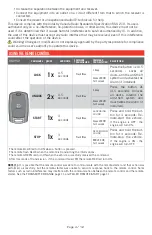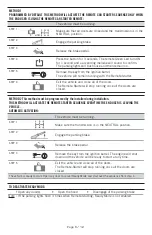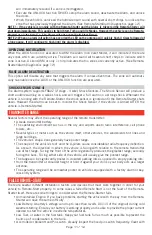
will immediately resound if a zone is (re)triggered.
•
Execute the UNLOCK function TWICE to stop the alarm sound, deactivate the Alarm, and unlock
the doors.
•
When the vehicle is unlocked the horn/siren will sound with several short chirps to indicate the
zone that has previously triggered the Alarm. (See Remote-Start/Alarm Diagnostics page 12)
NOTE 1: If the vehicle is running with the Remote-Starter and the Alarm is triggered the Remote-Starter will
shut down immediately. This applies to Cold Start, Turbo and Idle Modes. However the vehicle can be Remote-
Started at a later time (i.e. The Alarm will not cancel Cold Start Timer).
NOTE 2: When an alarm infraction has occurred the LED on the antenna will quickly fl ash 3 times followed of
a long pause. It will continue to fl ash until the alarm is disabled.
OPEN ZONE NOTIFICATION
When the LOCK function is executed to ARM the Alarm (non Valet Mode), it will indicate if there are
any zones which are currently active. The Alarm will sound with several short chirps to indicate which
zone is active. A silent ARM or only 1 chirp indicates that no zones are currently active. (See Remote-
Starter/Alarm Diagnostics page 12)
FALSE ALARM DEACTIVATION
This option will disable any zone that triggers the alarm 3 consecutive times. The zone will automati-
cally re-enable once the LOCK or the UNLOCK function are executed.
SHOCK SENSOR (ZONE 4)
The Alarm system supports FSS2Z (2 stage - 3 wire) Shock Sensors. The Shock Sensor will produce a
short audible warning on a weak shock, and will trigger a full alarm on a strong shock. Whenever the
vehicle is running with the Remote-Starter the shock sensor is ignored until the Remote-Starter shuts
down. However the Alarm can be set to monitor the Shock Sensor if the vehicle is Armed AFTER the
vehicle is Remote-Started.
TRANSMITTER RANGE
Several factors may affect the operating range of the remote transmitter:
•
A weak transmitter battery.
•
The operating environment such as in the city and airports due to radio interference, cell phone
towers, etc…
•
Several types of metal such as the vehicle itself, other vehicles, the windshields tint lines and
large buildings.
•
The vehicle’s shape. Vans generally have poorer range.
•
The shape of the vehicle’s roof and the A-pillars cause considerable radio-frequency defl ection.
As a result, the direction in which the vehicle is facing with relation to the remote transmitter
can affect range. Facing the front of the vehicle generally produces the greatest range; secondly
facing the back. Facing either side of the vehicle will usually give the poorest range.
•
The range will be signifi cantly poorer in crowded parking lots as opposed to empty parking lots.
•
Hold the transmitter at shoulder height or hold it against your chin so your body acts as a larger
antenna.
•
The operating range will be somewhat poorer on vehicles equipped with a factory alarm or key-
less entry system.
FAILED REMOTE-START
There are several different installation factors and devices that must work together in order for your
vehicle to Remote-Start properly. In some cases a failed Remote Start is not the fault of the Remote-
Starter itself. Here are some things to consider when the Remote-Starter fails.
•
Unmaintained Engine. If you have problems starting the vehicle with the key then the Remote-
Starter will have the same diffi culty.
•
Low Battery. A battery’s voltage can drop to less than 4 volts DC (1/3 of the original) during cold
weather starting. Ensure your battery is working properly and is able to provide the proper current
needed to start the vehicle in extreme temperatures.
•
Low Fuel, or water in the fuel tank. Keep your fuel tank full as much as possible to prevent the
build-up of condensation in the tank..
•
A corroded or broken Hood Pin switch. Visually inspect the hood pin switch frequently. Cover with
Page 11 / 12
Содержание ANT900
Страница 13: ...USER GUIDE Page 13 12...













